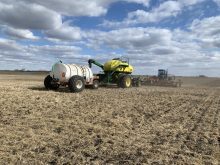In December 1923, wheat fell to just 99 cents per bushel, far from the late wartime and post-war price range of more than $2.
After government gave up its wartime price controls, farmers (and traders) were going broke.
Being Canada, the government appointed a Royal Commission to study the issue of low grain prices, and in 1925 a serious and stentorian report filled with useful recommendations was studiously ignored by left, right and centre.
You can imagine that The Western Producer covered this situation at length, and you’d be right if you were just talking about 1923 onwards. That’s because the WP was born in 1923, and arguments about marketing systems and farmer struggles in lean times have often dominated our pages.
Read Also

Government, industry seek canola tariff resolution
Governments and industry continue to discuss how best to deal with Chinese tariffs on Canadian agricultural products, particularly canola.
That year was the year when the co-operative prairie pools rose to challenge the privately owned grain trade, and there was much thundering rhetoric.
These were the days when farm leader and United Grain Growers founder Edward Partridge described the Winnipeg Grain Exchange as an oligarchy “with a gambling hell thrown in.”
The Western Producer was part of that farmer uprising, and became a part of Saskatchewan Wheat Pool, so you can also probably imagine the nature of our coverage in those early years.
Explosive rhetoric makes for fun reading and the following decades have seen grain farming and marketing pugilists take swings at each other, not with fists, but in the more peaceful form of black-ink letters and words printed on newsprint. Like athletic competitions, having journalistic arenas like newspapers in which to compete provides a way for people to avoid punching each other in the face.
But our pages have mostly been filled with more mundane and, I’d argue, more useful, content of a factual, constructive and informative nature. These include the most recent grain prices (always the first thing many farmers would look at), agronomic advice on how to deal with crop diseases, veterinary counsel on calf scours, nutritious recipes from home economists for the farm homemaker and a plethora of other “news you can use” that often gets overlooked when we look back through history.
For this past century, The Western Producer has been trying to help the western Canadian farmer make informed decisions to allow them to survive, thrive and advance within the brutal economics of prairie farming.
A big part of that has been information on the markets, from prices to problems to policies to opportunities.
In recent decades, our Markets section has been the favourite part of our publication for thousands of readers, and for good reason. However good a farmer is at pulling off a crop, it doesn’t mean much if it doesn’t fetch a good dollar.
Anything that’s going to affect that, matters.
The issues change, morph, come and go, but the underlying dynamics never do. Farmers are scattered, isolated and individually weak. The buyers and marketers are few, concentrated and powerful. Achieving a fair deal and a profitable price for the individual farmer has always been at the core of most farmers’ concerns with marketing policy and issues.
At The Western Producer, we like to believe we’ve been a key part of your ability to survive, thrive and evolve. People like me who write for our Markets section like to believe we’re helping you understand the environment in which you have to make such critical decisions. We’re not in the business of telling you what to do — there are plenty of others who are keen to do that — but we try to find, dig up, winkle out critical bits of information, analysis and opinion that might help you make better decisions.
Our role has changed over this past century. At one time, we were the main news source for tens of thousands of western Canadian farm families. I remember being astounded at finding that we ran the 1940 Dunkirk evacuation as front pages news, but I shouldn’t have been. For most families, we were probably the only newspaper they received, and we were where they found out about everything that went beyond the few words they heard on the radio.
I joined the paper in 1994, and by then those days were well behind us. We had evolved to the role of “newspaper of record” for western Canadian agriculture, but that was already waning when I got aboard the good ship Producer.
As the internet unfolded in front of my eyes, I could see us moving into that digital space, and away from thinking people would wait patiently for Thursday to find out what happened last week. We became more analytical, more contextual. Instead of trying to tell you what happened in the world, we have tried to give you the tools to figure out for yourself what it means for you on your farm.
We’ve become a media organization rather than a newspaper, and we try to be wherever we need to be in order to be useful to you. We’re there on our app, which should be on your phone. We’re there on our website, where there’s a library of knowledge for your perusal. We’re there on social media, where many of you, like me, buzz around a bunch. And we come at you every day with a great newsletter, which you should all sign up for.
I hope we help you make better decisions that help you farm better. That’s what we strive for.
I don’t know what we’ll look like in 2123. If you do, give me the heads-up and I’ll get my great-grandchildren ready for it.
But I am certain The Western Producer will remain an important part of every prairie farmer’s operation, and I hope you can tell your great-grandchildren about what it was like when The Western Producer was only 100.


















